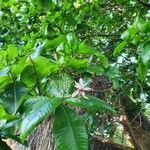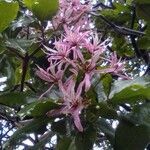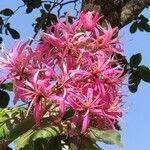Tree up to 20 m. high; young branches, leaves and inflorescences densely tomentose with simple, stellate and branched hairs, soon becoming glabrous.. Leaf-lamina elliptic, 6–14(–18) cm. long, 3.5–8(–11) cm. broad, acute or slightly apiculate or rounded at the apex, cuneate to slightly cordate at the base; petiole 2–10 mm. long.. Inflorescence up to 15 cm. long, with opposite cymose branches.. Flowers mauve; bracteoles linear, 1.3–1.5 mm. long, caducous; pedicel up to 20 mm. long.. Sepals ovate, 3–5 mm. long, 1.8 mm. broad, free or slightly connate at the base, minutely tomentose.. Petals narrowly oblanceolate, 20–35 mm. long, 5–7 mm. broad, whitish or mauve, straight or somewhat recurved, tomentose with simple or branched hairs on the outside and simple hairs directed downwards inside.. Stamens as long as the petals; anthers 1.3–1.5 mm. long; staminodes longer than the petals, very narrowly oblanceolate, caudate, dotted with bright crimson glands.. Gynophore 4–6 mm. long, glandular; ovary 2–3 mm. in diameter; style 15–20 mm. long.. Fruit 5-lobed, strongly rugose-warty, ± 35 mm. in diameter, dehiscing from below with the 5 valves remaining attached to the top of a central column.. Seeds black, semi-spherical to pyramid-like, 10–15 mm. in diameter.. Fig. 4/1–6, p. 12.
Tree, evergreen or deciduous, 7-22 m high. Leaves opposite, simple, petiolate, elliptic, 60-180 x 35-90 mm, gland-dotted. Flowers in large, terminal, paniculate racemes, pink-dotted mauve. Sepals 5, somewhat fleshy, valvate, spreading when mature. Petals 5, linear, imbricate. Disc cupular. Stamens usually 5 fertile and equalling petals, and 5 petaloid staminodes with immersed glands; anthers with immersed apical gland. Ovary stalked, 5-lobed, 5-locular, ovoid, tuberculate, with stipitate glands at apex, with 2 ovules in each locule; style much longer than ovary, glandular; stigma subcapitate. Flowering time Sept.-Dec. Fruit a woody, 5-angled capsule covered with blunt protuberances; seeds large, black, shiny, containing oil.
A small to medium sized tree. It grows 7-20 m high. The bark is grey and smooth. It has buttresses. It has a spreading crown. The leaves are opposite and simple. They are large and oblong. They are 6-13 cm long by 3.5-7.5 cm wide. They can be 22 cm long. They are dark green with scattered gland-dots. The edges can be wavy. The flowers are large and striking. The petals can be white or pink. They are like feathers. The flowers are long and narrow. They are 4 cm long by 0.5 cm wide. Flowers have both sexes. The fruit is a brown capsule. It is 3.5 cm across. It has 5 lobes and is woody. It has a knobbly surface.
Tree, up to 20 m high; deciduous to semideciduous; bark smooth. Leaves opposite; blade elliptic to broadly elliptic, 60-130(-180) x 35-75(-110) mm; apex acute, gland-dotted. Flowers: in large clusters at ends of branches; stamens 5, alternating with 5 petaloid staminodes, staminodes narrowly obovate, caudate, dotted with bright crimson glands; corolla pink; Sep.-Mar. Fruit a 5-angled, rugose, warty capsule.
Tree, up to 20 m high. Leaves elliptic to broadly elliptic, 60-130(-180) x 35-75(-110) mm. Stamens 5, alternating with 5 petaloid staminodes. Staminodes narrowly oblanceolate, caudate, dotted with bright crimson glands. Fruit a 5-lobed, rugose, warty capsule. Flowers pink.
Stamens as long as the petals, inserted at the base of an annular disk; filaments filiform; anthers 1·3–1·5 mm. long, dorsifixed, sagittate; staminodes longer than the petals, very narrowly oblanceolate, caudate, dotted with bright crimson glands.
Petals 3–3·5 × 0·6–0·7 cm., narrowly oblanceolate, straight or somewhat recurved, whitish or mauve, tomentose with simple or branched hairs on the outside and simple hairs directed downwards inside.
Leaf-lamina 6–13 (18) × 3·5–7·5 (11) cm., elliptic to broadly elliptic, acute or slightly apiculate or rounded at the apex, cuneate or obtuse or slightly cordate at the base; petiole 2–10 mm. long.
Fruit a 5-lobed strongly rugose warty septicidal capsule 3·5 cm. in diam., dehiscing from below with the 5 valves remaining attached to the top of a central column.
Sepals 3·2 × 1·8 mm., free or slightly united at the base, ovate, minutely tomentose with branched hairs on the outer surface and simple sericeous hairs within.
Evergreen tree to 20 m. Leaves simple, elliptic, aromatic. Flowers in terminal panicles, large, pink dotted mauve. Capsules large and conspicuously warty.
Tree up to 20 m. tall; young branches, leaves and inflorescences densely tomentose with mixed simple, stellate and branched hairs, soon becoming glabrous.
Flowers erect, mauve; bracteoles 1·3–1·5 mm. long, linear, caducous; pedicels up to 1·5 cm. long, stout.
Ovary 2–3 mm. in diam., globose, apiculate, papillose; style 18–20 mm. long; stigma capitate.
Inflorescence up to 15 cm. long, with opposite cymose branches.
Gynophore 5 mm. long, glandular.




